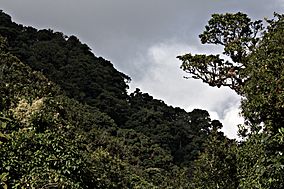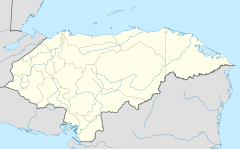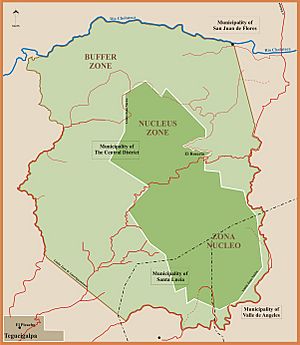La Tigra National Park facts for kids
Quick facts for kids La Tigra National Park |
|
|---|---|
|
IUCN Category II (National Park)
|
|

La Tigra National Park
|
|
| Location | Francisco Morazán Department, Honduras |
| Nearest city | Tegucigalpa |
| Area | 238.21 km2 (91.97 sq mi) |
| Established | 1 January 1980 |
| Governing body | AMITIGRA |
La Tigra National Park (Spanish: Parque Nacional La Tigra) is a super important natural area in Honduras. It was the very first national park created in the country, back on January 1, 1980! Its main goal is to protect nature, keep the environment healthy, and make sure there's enough water for everyone. The park covers a huge area of about 238 square kilometers and is located high up in the mountains, between 1,800 and 2,185 meters above sea level.
This amazing park is not just a beautiful place; it's also super important for the city of Tegucigalpa, the capital of Honduras. The cloud forest in La Tigra provides more than 30% of the water needed by Tegucigalpa. It also supplies 100% of the water for the towns nearby. People have been protecting this area since the 1920s, which shows how valuable it is. The park is about 25 kilometers (15 miles) from Tegucigalpa.
Contents
Visiting La Tigra National Park
The park is located north of Tegucigalpa. There are a few ways to get there, but most visitors use two main roads. One road goes towards El Hatillo, and the other goes towards Valle de Ángeles, San Juancito, and Cantarranas.
Visitor Centers and Eco Lodges
La Tigra National Park has two special places called Visitor Centers and Eco Lodges. These are great spots to start your adventure!
- One center is in the community of Jutiapa. You can reach it by taking the road to El Hatillo. The drive is about 22 kilometers (14 miles) and takes around 50 minutes. You'll pass through several small towns on your way.
- The other center is in the community of El Rosario. To get there, you take the road towards Valle de Ángeles and San Juancito. This drive is about 36 kilometers (22 miles) from Tegucigalpa. The El Rosario center is located at an elevation of about 1,650 meters (5,413 feet) and even has a museum!
Park Zones and Hiking Trails
The park, which is about 240 square kilometers (93 square miles), is divided into two main parts: the nucleus zone and the buffer zone. The nucleus zone is the most protected part.
This core area has 8 different hiking trails that stretch for more than 23 kilometers (14 miles). Two of these trails even connect the two visitor centers, so you can hike between them!
Plants and Animals of La Tigra
La Tigra National Park is home to many different kinds of plants and animals. It's a fantastic place to see wildlife!
Amazing Animals
The park has a wide variety of creatures:
- About 3 types of amphibians (like frogs and salamanders).
- 13 types of reptiles (like snakes and lizards), including some rare and a couple of venomous ones.
- Over 200 types of birds! These include both birds that live there all the time and birds that migrate through.
- 31 types of mammals. Some of these mammals are endangered, meaning they are at risk of disappearing forever. Others are considered threatened or rare.
Wonderful Plants
The forest is filled with many interesting plants, including:
- Bromeliads, which are plants that often grow on other plants.
- Lots of ferns and moss.
- Different kinds of fungi.
- Giant trees like oaks, encino, and pines.
- The ceibo tree, which was considered sacred by the ancient Mayans.
- You can also find avocado trees, which are a very important food source for the beautiful quetzal bird.
Activities for Visitors
La Tigra offers exciting activities for those who love adventure and nature!
Canopy Adventure
One popular activity is the canopy tour. This adventure lets you zip through the treetops on a series of cables. The canopy course is 1 kilometer (about half a mile) long and includes:
- 7 zip lines.
- 2 hanging bridges that sway as you cross them.
- 10 platforms, some of which are as high as 25 meters (82 feet) above the ground!
To plan your visit, it's a good idea to contact the park's main office. You can also check their website for information about what you need to know and the rules for visiting.
See also
 In Spanish: Parque nacional La Tigra para niños
In Spanish: Parque nacional La Tigra para niños



